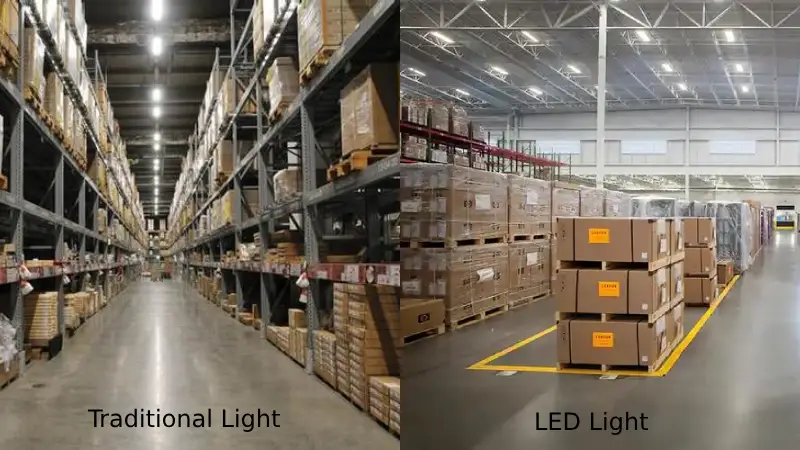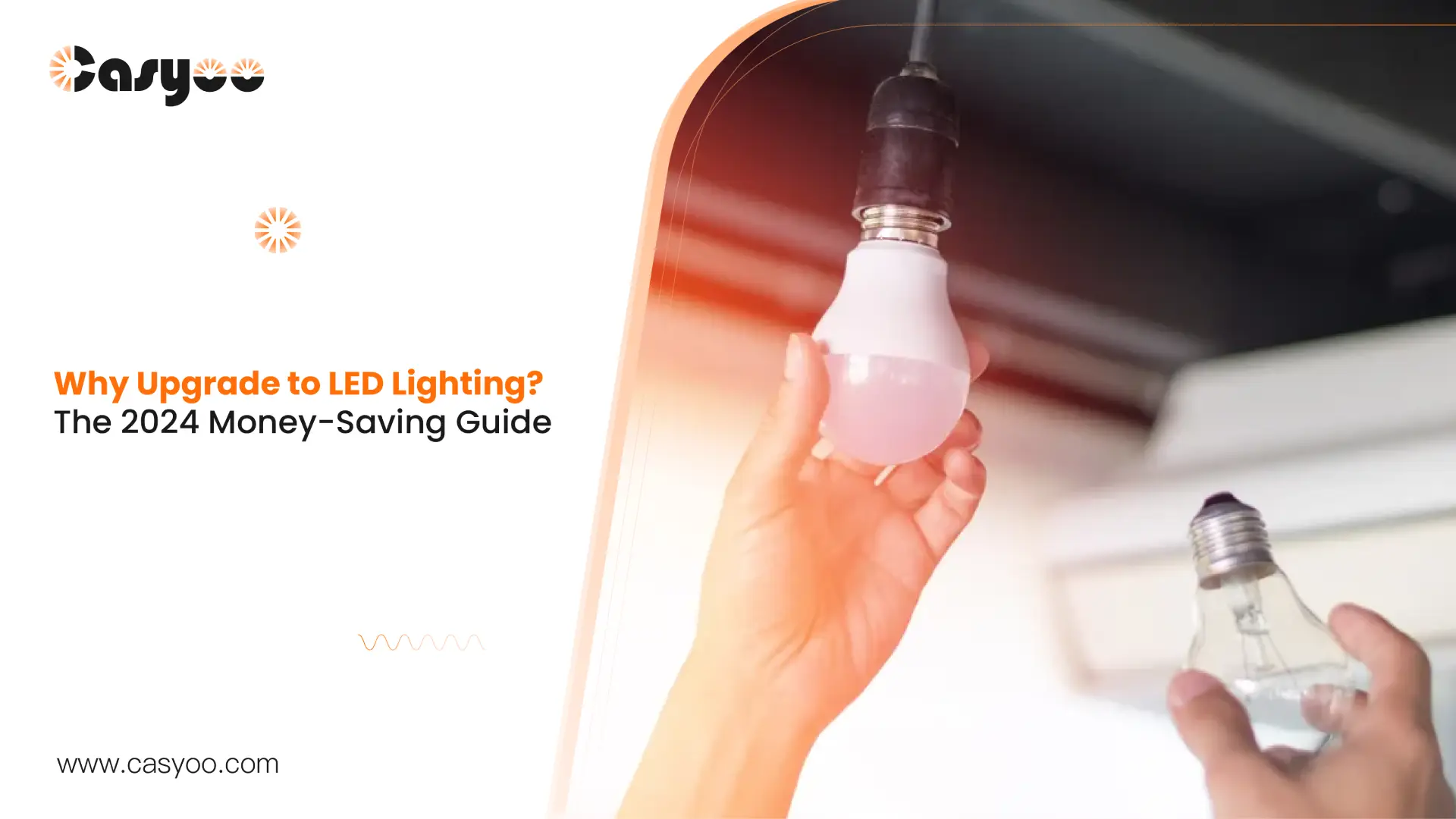Does your facility still use conventional lighting? You could be physically watching your money burn away. As an LED lighting engineer with over 7 years of experience, I’ve witnessed several businesses battle with rising energy costs and frequent bulb replacements. The good news is that there has never been a better time to switch to LED lighting.
The Hidden Cost of Traditional Lighting
Consider your present lighting system to be an ancient, gas-guzzling car. Sure, it still works, but each mile costs you more than it should. LED technology enables unprecedented control over light direction and dispersion. That’s equivalent to paying for a full tank of gas and just using 10% of it to drive.
According to the U.S. Energy Information Administration, lighting consumes around 17% of all electricity in commercial buildings. As energy costs continue to grow, this percentage will account for an increasing portion of your operating expenses.
Why Now is the Perfect Time to Make the Switch
Energy Cost Trends
According to recent data from the US Energy Information Administration, commercial power costs will rise 2.4% in 2024. Total electricity expenses have increased by 2.6%. The impact varies greatly by geography, ranging from 8.00 cents per kWh in North Dakota to 29.06 cents per kWh in California, demonstrating how energy-efficient lighting can provide varied degrees of savings depending on location.
Technology Maturity
The LED market has reached a critical maturity level. LED bulb prices fell 32% per year between 2011 and 2015, with each doubling of production resulting in an 18% price decrease. The global market for upgradeable streetlights is expected to grow to 352 million points by 2025, offering a €51.9 billion opportunity.
Investment Support
The government’s support for energy-efficient lighting grows through a variety of rebate and incentive programs. Many regions provide significant financial assistance for LED improvements as part of their energy saving efforts.
Timing & ROI
The current market gives an excellent opportunity for LED upgrading. The combination of growing energy costs, maturing technology, falling LED pricing, and available incentives makes a compelling case for investment. With documented three-year payback timeframes, each delay in switching to LED lighting results in additional avoidable operational costs.
LED vs Traditional Lighting: The Numbers Don’t Lie
Traditional 400W metal halide bulbs need to be replaced after 20,000 hours, whereas identical LED fixtures use only 150W and last over 50,000 hours. This equates to a 62.5% reduction in energy usage and a 2.5 times longer operational lifespan. The global impact of switching to LED technology is also impressive, with potential energy cost savings of €187.1 billion, the removal of 1,250 planned power plants, and a decrease in CO2 emissions of nearly 1,400 million tons. These estimates are based on substantial academic study and recorded implementations in a variety of metropolitan locations.
Performance Advantages of LED lights
Operational Excellence
Modern LED systems provide rapid illumination without the warm-up period that traditional lighting requires. This quick reaction capabilities not only improves the user experience but also increases safety in applications that require immediate lighting, such as emergency exits and security systems.
Light Quality Control
LED technology enables unprecedented control over light direction and dispersion. Unlike traditional bulbs, which spread light in all directions, LEDs can direct illumination precisely where it is required, eliminating light pollution and increasing efficiency. The flexibility to change color temperatures provides for appropriate lighting conditions in a variety of locations, from warm, welcoming retail spaces to sharp, productivity-boosting office settings.
Advanced Integration Features
LED lighting stands out in today’s built environment due to its connectivity with smart control systems. These systems are compatible with occupancy sensors, daylight harvesting systems, and building management platforms. Furthermore, LED fixtures produce little UV and infrared radiation, making them safer for light-sensitive areas and lowering heat accumulation in confined spaces.
Enhanced Thermal Resilience
Modern LED thermal management technologies have practically eliminated early failures. Heat dissipation technology has improved to the point where LEDs may function successfully in harsh industrial conditions above 45°C (113°F).
Practical Applications Across Industries
Lighting options fluctuate depending on the environment. In warehouses, high-bay LEDs with motion sensors can dramatically cut energy use, particularly in low-traffic regions. White lighting in retail spaces can be changed throughout the day to create the perfect shopping environment.
Commercial Spaces
Office settings necessitate careful consideration of both job lighting and ambient conditions. LED systems can be set to match circadian rhythms, which could boost worker alertness and productivity. Studies have demonstrated that deploying such methods results in significant reductions in afternoon fatigue complaints.
Industrial Applications
Manufacturing facilities encounter unique obstacles. LED installations must tolerate vibration, dust, and high temperatures. Modern industrial LED fixtures are designed expressly for these situations, with strong thermal management systems that allow them to function consistently even in high-temperature applications.

Implementation Guide: Making a Smooth Transition
Infrastructure Assessment
Before beginning any LED update, a complete study of your current lighting system is required. This includes examining mounting heights, ambient temperatures, and current control systems. Understanding these criteria leads to optimal fixture selection and installation success.
Performance Metrics
When selecting LED fixtures, lumen output should be prioritized over wattage. Choose the appropriate lumens by considering the lux level for different spaces. LED technology often uses substantially less electricity to attain the same illumination levels as traditional lighting, owing to better light direction and little deterioration over time.
Light Distribution Design
Because LED fixtures are directional, they must be carefully considered in terms of light distribution patterns. Professional lighting design guarantees equal illumination while preventing common problems such as dark spots and glare. The goal should be to achieve the required lighting levels rather than merely matching present watts.
Color Temperature Selection
Different situations necessitate specific color temperatures for best outcomes. While industrial rooms frequently benefit from colder lighting for increased visibility, office settings typically require warmer tones to create a welcoming ambiance. This customisation has a considerable impact on both functionality and occupant comfort.
Smart Installation Sequence
Begin with your most frequently used places. The energy savings from these first renovations can help fund future parts of your project. Consider this proved sequence:
- Replace constantly-running fixtures first
- Upgrade regions with high electricity prices during peak hours
- Address spaces with frequent bulb replacements
- Convert places that require higher light quality
Practical Tips from the Field
Do not rush to remove all of your present fittings. Many new LED solutions may be retrofitted into existing housings, thus lowering installation costs. Install occupancy sensors in low-traffic locations, like restrooms and storage rooms, to optimize savings.
Avoiding Common Pitfalls
Installing LEDs without taking the environment into account is a typical error. In high-temperature environments such as industrial kitchens or production facilities, make sure your fixtures are rated for the working temperature range. Standard LEDs can fail early in high temperatures.
Real-World Implementation Success
The initial expense of LED lighting is often questioned, but let’s put it in context. Cities worldwide have proved the extraordinary benefits of implementing LED lighting:
Adelaide’s LED Street Lighting Project:
- Light intensity increased fourfold compared to traditional lighting
- 4% reduction in energy consumption
- Reduced annual CO2 emissions by 1,300 tons
- Improved public safety with improved illumination
Hong Kong University Case Study:
- Achieved an impressive 89% energy reduction
- Provided consistent performance over time.
- Improved visibility and lighting quality
New York Central Park Implementation:
- Basic LED installation can save 50-70% energy
- Combine with smart controls to save up to 80%
- Proven long-term reliability with low light degradation
Lighting the Way Forward
Every day, organizations make several decisions concerning infrastructure and operations. Lighting, however, is about more than simply infrastructure; it is also about the people who work, learn, and live under it. It’s about the worker who can now read technical drawings more clearly, the student who has less eye strain while studying in the evening, and the night shift employee who feels safer in a well-lit parking area.
When we think at lighting in this way, the option is clear: upgrading to LED is more than simply a business decision; it is an investment in your employees’ comfort, safety, and productivity. The technology is ready. The benefits have been proved.
Want to find the best LED solution for your specific space? Our lighting experts are ready to do a thorough examination of your business and design a lighting plan that improves both energy efficiency and user comfort. Contact us today for a free consultation, and we’ll help you illuminate a better future for your business.




